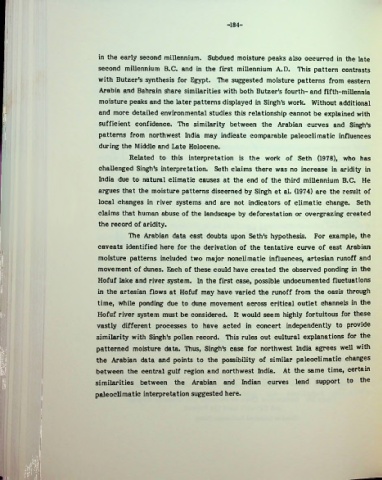Page 208 - Life & Land Use on the Bahrain Islands (Curtis E Larsen)
P. 208
-184-
in the early second millennium. Subdued moisture peaks also occurred in the late
second millennium B.C. and in the first millennium A.D. This pattern contrasts
with ButzerTs synthesis for Egypt. The suggested moisture patterns from eastern
Arabia and Bahrain share similarities with both Butzer's fourth- and fifth-millennia
moisture peaks and the later patterns displayed in Singh's work. Without additional
and more detailed environmental studies this relationship cannot be explained with
sufficient confidence. The similarity between the Arabian curves and Singh's
patterns from northwest India may indicate comparable paleoclimatic influences
during the Middle and Late Holocene.
Related to this interpretation is the work of Seth (1978), who has
challenged Singh's interpretation. Seth claims there was no increase in aridity in
India due to natural climatic causes at the end of the third millennium B.C. He
argues that the moisture patterns discerned by Singh et al. (1974) are the result of
local changes in river systems and are not indicators of climatic change. Seth
claims that human abuse of the landscape by deforestation or overgrazing created
the record of aridity.
The Arabian data cast doubts upon Seth’s hypothesis. For example, the
caveats identified here for the derivation of the tentative curve of east Arabian
moisture patterns included two major nonclimatic influences, artesian runoff and
movement of dunes. Each of these could have created the observed ponding in the
Hofuf lake and river system. In the first case, possible undocumented fluctuations
in the artesian flows at Hofuf may have varied the runoff from the oasis through
time, while ponding due to dune movement across critical outlet channels in the
Hofuf river system must be considered. It would seem highly fortuitous for these
vastly different processes to have acted in concert independently to provide
similarity with Singh's pollen record. TTiis rules out cultural explanations for the
patterned moisture data. Thus, Singh's case for northwest India agrees well with
the Arabian data and points to the possibility of similar paleoclimatic changes
between the central gulf region and northwest India. At the same time, certain
similarities between the Arabian and Indian curves lend support to the
paleoclimatic interpretation suggested here.

